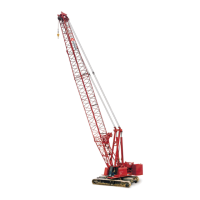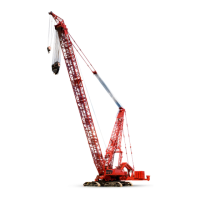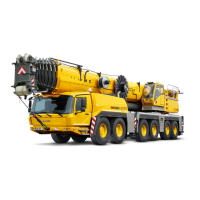INTRODUCTION 777 SERVICE MANUAL
1-18 Published 10-01-2012, Control # 045-08
in the form of binary counts at crucial points during lift crane
operation.
The PC uses the pressure senders in any liftcrane full power
operation to determine the oil pressure needed to hold the
load, boom, or luffing jib (optional) and prevent it from
lowering momentarily when starting after releasing the
brake.
• Drum speed senders detect the amount and direction of
drum movement. The PC receives this information in the
form of two out-of-phase square wave voltages. (For
example, after this information is received from the
encoder, the PC will signal the display to print the drum
rotational speed, drum rotational direction (+ on display
for HOIST UP) (- on display for HOIST LOWER), and
actuate the handle thumper in a proportional rhythm to
the impulse received.)
The PC uses the speed senders to determine when to apply
the brakes and to trim or adjust pump flow.
The PC also uses the monitored data and programmed
memory in providing voltage and hydraulic solenoids for
automatic control of the brakes and clutches in their
operational systems.
The operational systems function in direct relation to the
control handle commands while the PC automatically
accounts for system conditions, equipment positions, and
desired actions or limitations entered into the PC’s program
directives.
Standard Crane Mode
Hoisting or lowering a load are operations performed using
the load drums. Raising or lowering are operations
performed with the boom. For simplification, the handle
commands for these operations will be referred to as up or
down.
When an up or down command is received from a control
handle in full power mode, the PC compares the command
with current operating information (i.e. hydraulic sender
voltage readings) and to previously memorized information
(pressure memory) in order to control brake application and
pump output. Enough system pressure must be available to
hold the load before the PC releases the brakes. This also
prevents momentary lowering of the load. Should there be a
change pressure loss, the brakes are automatically applied.
The control handle position provides a linear electric analog
input to the PC, increasing or decreasing in proportion to the
handle movement. The PC responds to the handle
movement with an analog output to the pump EDC that is
appropriate for the task being performed. For example, in
drum operation, the program provides more precise control
needed during initial handle movement.
The PC receives the linear analog input handle voltage and
adjusts the voltage output to the appropriate load drum hoist
pump EDC and motor PCP. During hoisting, the voltage is
increased at a slower rate during the first half of handle travel
than the last half. During lowering, the voltage is decreased
at a slower rate as the handle gets closer to the off position
until a switch in the handle opens the control circuit to the PC
at the off position.
The voltage sent to the pump EDC is either negative or
positive (0 to 2.7 volts) as appropriate to obtain commanded
operation direction. The EDC tilts the pump swashplate to a
position that strokes the pump to obtain the flow amount
needed to perform the operation speed commanded: the
more voltage received, the more the EDC tilts the
swashplate. Operation is regulated in response to movement
of the handle. Oil then flows from pump to motor; and at the
appropriate moment when pressure memory is met, the PC
releases the drum brakes.
When the load drums have clutches and when operating in
full power mode, the PC compares the drum speed sender
output to the motor speed sender output to determine a
speed difference. If there is a speed difference of the drum
while lowering or if the drum lowers while raising (indicating a
faulty clutch), the PC will apply the drum brakes.
As the control handle is moved back toward the off position,
the PC proportionally decreases voltage to the EDC to
decrease pump output flow. When the control handle is
moved near the off position, the PC applies the park brakes.
Brake Application
As the control handle nears the off position, the PC
compensates for hydraulic system leakage. Changing load
weight or changing engine speed causes system leakage.
The PC adjusts the swashplate in the up direction until the
load is supported, the handle command is off, and the drum
speed sensor output is zero (indicating the drum has
stopped moving). The PC then memorizes the holding
pressure and applies the park brakes.
Brake Release
In all operation commands, even after an engine shutdown,
the PC will not release the brakes until there is sufficient
pump displacement (pressure memory) to hold the load.
In an up operation, when the previously memorized holding
pressure is reached as determined from the pressure
senders, the PC releases the park brakes and movement
begins.
In a down operation, the PC first tilts the swashplate
momentarily in the up direction by applying voltage to the
EDC opposite to the control handle command. The PC then
releases the park brakes when the previously memorized
holding pressure is reached. After releasing the brakes, the
PC reverses the voltage polarity to the EDC and responds
directly to the control handle down command.
Other Crane Modes
The PC activates brake and clutch application, controls
pump speeds, and arranges control handle use depending
on crane operation modes.

